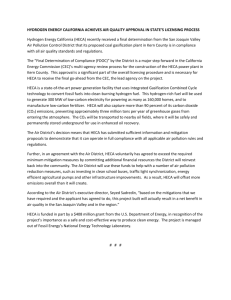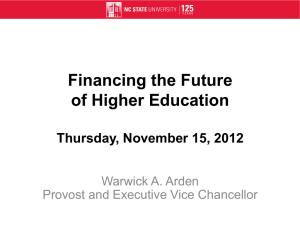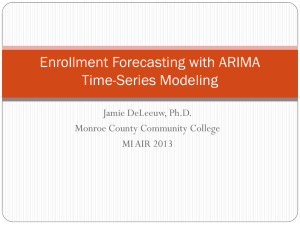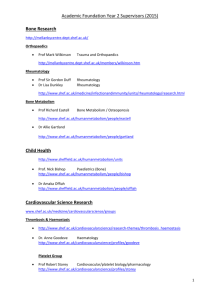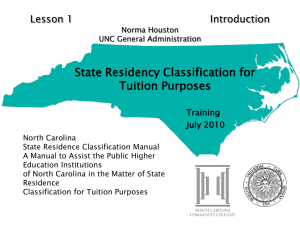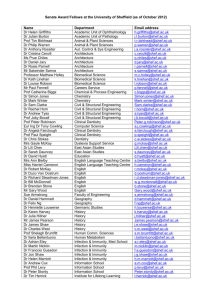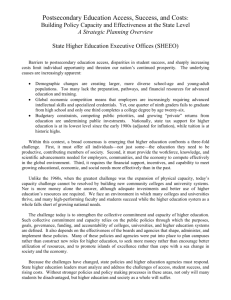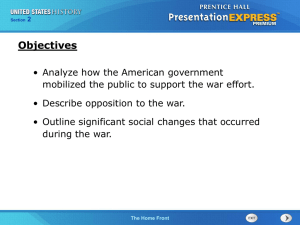State Higher Education Finance Fiscal Year 2012
advertisement
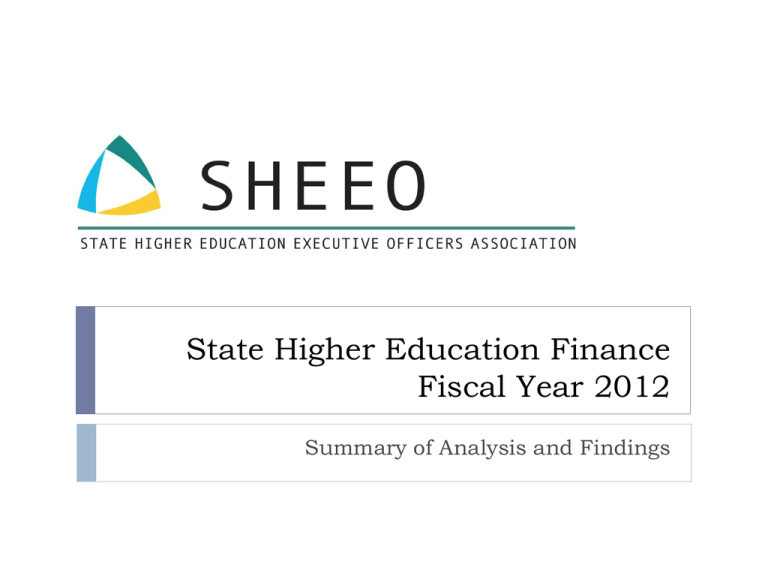
State Higher Education Finance Fiscal Year 2012 Summary of Analysis and Findings Agenda History of the SHEF Project SHEF Metrics and Adjustments HECA vs. CPI Summary of FY 2012 Findings National State-level Additional Data / Analysis Opportunities SHEF History The tenth report, SHEF FY 2012, was released on March 6, 2013 SHEF builds upon Dr. Kent Halstead’s “Halstead Finance Survey” and the corresponding data going back to 1972 Halstead ceased publishing his study in 1998. SHEEO membership encouraged SHEEO to embark on a similar study moving forward SHEF History Halstead transferred his dataset to SHEEO which became the historical basis for SHEF First SHEF report released in 2004 for FY 2003 SHEEO moved to an online data collection tool (SSDB) in 2010 and aligned the SHEF Survey with the Grapevine Survey maintained by Illinois State University What’s the Difference? Grapevine The first look at state appropriations in the current fiscal year Typically released in December or January http://grapevine.illinoisstat e.edu/ Since 1960 SHEF A more detailed look at state and local appropriations, tuition revenue, and enrollment for the most recent completed fiscal year Typically released in March http://www.sheeo.org Since 2003, with data going back to 1980 What SHEF does not measure Direct tuition rate increases SHEF measures tuition revenue over time which may increase due to tuition rate increases, enrollment growth, and changes in enrollment mix (e.g., more non-resident students or more graduate students) College Board is a better source for specific tuition rate information SHEF Metrics State and Local Support Educational Appropriations Net Tuition Revenue Full-Time Equivalent Enrollment (FTE) Total Educational Revenue Make up the Wave Chart SHEF Adjustments - HECA Higher Education Cost Adjustment (HECA) To measure inflation over time, $s adjusted to current year SHEEO developed as an alternative to CPI and HEPI as a means to account for the “market basket of goods” higher education must purchase, that is, primarily personnel costs Constructed from two existing federal indices - the Employee Cost Index (75%) and GDP-Implicit Price Deflator (25%) FY 2011 appropriation: $1000 Divide by corresponding HECA: $1000/0.9824 FY 2011 appropriation in FY 2012 $s: $1018 HECA vs. CPI - HECA Criticisms HECA’s critics argue that HECA has historically grown more quickly than CPI and therefore overstates the amount of support institutions need in order to keep up with inflation A further critique is that HECA is a meaningless figure for families struggling to pay tuition costs CPI HECA HECA vs. CPI - SHEEO’s Response Institutions of higher education primary costs are driven by personnel expenditures which make up the bulk of the higher education “market basket of goods.” SHEF’s intent is to measure trends in revenue for educational delivery. HECA is a reasonable means to compare available revenue to necessary expenditures Little difference between CPI and HECA since 2007, due to flat salaries. Since 2010, CPI is growing faster than HECA CPI is a better measure for tuition rate increases, which SHEF does not measure. SHEF tracks changes in net tuition revenues SHEF Adjustments – EMI and COLA Enrollment Mix Index (EMI) To adjust for differences in the mix of enrollment and costs among types of institutions among the states Aggregated IPEDS data Cost of Living Adjustment (COLA) To account for cost of living differences among the states Derived from the 2003 Berry Index that provides a single index for each state State X with $1000 educational appropriation Adjust by EMI: $1000/0.95 = $1053 Adjust by EMI and COLA: $1053/1.01 = $1043 National-level Findings Enrollment grew 15.6% since 2007 to over 11.5 million FTE in 2012 (down slightly from 2011) For the third year in a row, educational appropriations per student hit a 25-year low and were $5,906 in 2012 (down 23.0% since 2007) Net tuition revenue per student continued to increase, reaching $5,189 in 2012 (up 19.1% since 2007). It now makes up 47.0% of total educational revenue Tuition increases did not offset reductions in state and local support. Total educational revenue is down 7.9% since 2007 State-level Findings All fifty states grew enrollment since 2007, ranging from 4.2% growth in California to 36.2% in Oregon Two states, Illinois and North Dakota increased per student educational appropriations since 2007. Illinois’ increase is due to addressing the historic underfunding of its pension program 48 states decreased educational appropriations per FTE Percent of total revenue from net tuition ranges from 13.8% in Wyoming to 85.1% in Vermont in 2012 In 36 states, total educational revenue decreased since 2007, despite increases in net tuition revenue California Nevada Maine Illinois Wisconsin Louisiana Pennsylvania Rhode Island Michigan West Virginia North Dakota Delaware Oklahoma Minnesota Vermont Kansas Alabama Kentucky Nebraska Connecticut South Dakota New York US Montana Wyoming Hawaii Alaska Iowa Indiana New Mexico Washington Tennessee Massachusetts Ohio Virginia North Carolina Arizona Missouri South Carolina New Jersey New Hampshire Arkansas Colorado Texas Mississippi Maryland Florida Utah Georgia Idaho Oregon Figure 5 Full-Time Equivalent (FTE) Enrollment in Public Higher Education Percent Change by State, Fiscal 2007-2012 40% 36.2% 35% 30% 25% 20% 15.6% 15% 10% 5% 4.2% 0% Source: State Higher Education Executive Officers New Hampshire Florida Idaho South Carolina Arizona Washington Virginia Nevada Oregon Pennsylvania Tennessee Michigan Massachusetts Colorado Georgia Alabama Louisiana Iowa Minnesota Missouri Ohio Utah California Delaware Hawaii US New Mexico New Jersey Mississippi Kansas Oklahoma Maryland Rhode Island Kentucky South Dakota Connecticut Indiana Arkansas Vermont Wisconsin New York North Carolina Wyoming Maine Nebraska Texas Montana West Virginia Alaska Illinois North Dakota Figure 6 Educational Appropriations per FTE Percent Change by State, Fiscal 2007-2012 40% 30% 30.7% 20% 10% 0% -10% -20% -30% -23.0% -40% -50% -50.7% -60% Note: Dollars adjusted by 2012 HECA, Cost of Living Adjustment, and Enrollment Mix Index. Source: State Higher Education Executive Officers Wyoming New Mexico California Alaska North Carolina Hawaii Illinois Nevada New York Georgia Idaho Texas Arkansas Florida Nebraska Louisiana Oklahoma Washington Wisconsin Kentucky US Tennessee Utah Mississippi Connecticut North Dakota Missouri Kansas Massachusetts Maryland Arizona New Jersey Montana West Virginia Maine Indiana Oregon Iowa Alabama Minnesota Ohio Virginia Rhode Island South Carolina South Dakota Michigan Pennsylvania Colorado Delaware New Hampshire Vermont Figure 7 Net Tuition as a Percent of Public Higher Education Total Educational Revenue by State, Fiscal 2012 90% 85.1% 80% 70% 60% 50% 47.0% 40% 30% 20% 13.8% 10% 0% Note: Dollars adjusted by 2012 HECA, Cost of Living Adjustment, and Enrollment Mix. Source: State Higher Education Executive Officers Florida Idaho California Arkansas Nevada Louisiana Washington Tennessee Massachusetts South Carolina Wyoming New Mexico Missouri Arizona Ohio Georgia Oregon Maryland Hawaii Utah Oklahoma US Connecticut North Carolina Mississippi Kansas New Hampshire New York New Jersey Indiana Kentucky Iowa Alabama Wisconsin Texas Montana Michigan Pennsylvania Virginia Alaska Vermont Nebraska South Dakota Rhode Island Minnesota Colorado Maine Delaware West Virginia North Dakota Illinois Figure 8 Total Educational Revenue per FTE Percent Change by State, Fiscal 2007-2012 20% 15.6% 10% 0% -10% -7.9% -20% -25.9% -30% Note: Dollars adjusted by 2012 HECA, Cost of Living Adjustment, and Enrollment Mix; total educational revenue excludes net tuition revenue used for capital debt service. Source: State Higher Education Executive Officers Additional Data/Analysis Opportunities All the tables and charts The raw, unadjusted data State wave charts and data http://www.sheeo.org/shef12 SHEF in the News CBPP Analysis Combined SHEF, Grapevine, and College Board data to correlate tuition rate increases with cuts in state support Recent Deep State Higher Education Cuts may Harm Students and the Economy for Years to Come http://www.cbpp.org/cms/index.cfm?fa=view&id=3927 Questions? Please use the Chat Box Or contact Andy Carlson: acarlson@sheeo.org or 303-541-1607
